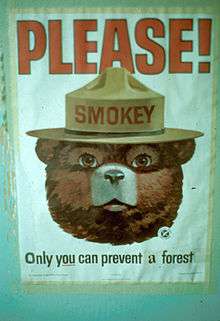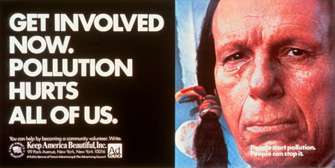Ad Council
 | |
| Founded | February 26, 1942[1] |
|---|---|
| 13-0417693[2] | |
| Legal status | 501(c)(3) nonprofit organization |
| Headquarters |
815 Second Avenue, New York, New York 10017[2] |
| Coordinates | 40°45′04″N 73°58′19″W / 40.7509767°N 73.9718453°WCoordinates: 40°45′04″N 73°58′19″W / 40.7509767°N 73.9718453°W |
Area served | United States |
| Products | Public service announcements[2] |
| David Christopher[3] | |
| Lisa Sherman[4] | |
Revenue (2014) | $44,571,027[2] |
| Expenses (2014) | $42,528,600[2] |
Employees (2013) | 153[2] |
Volunteers (2013) | 291[2] |
| Mission | To identify a select number of significant public issues and stimulate action on those issues through communications programs that make a measurable difference in our society.[2] |
| Website |
www |
Formerly called | The War Advertising Council, Inc. |
The Advertising Council, commonly known as the Ad Council, is an American non-profit organization that produces, distributes, and promotes public service announcements on behalf of various sponsors, including non-profit organizations, non-governmental organizations and agencies of the United States government.[5]
The Ad Council partners with advertising agencies who work pro bono to create the public service advertisements on behalf of their campaigns. The organization accepts requests from sponsor institutions for advertising campaigns that focus on particular social issues. To qualify, an issue must be non-partisan (though not necessarily unbiased) and have national relevance.
The Ad Council distributes the advertisements to a network of 33,000[6] media outlets—including broadcast, print, outdoor (i.e. billboards, bus stops), and Internet—who run the ads in donated time and space. Media outlets donate approximately $1.8 billion to Ad Council campaigns annually.[7] If paid for, this amount would make the Ad Council one of the largest advertisers in the country.[8]
History
The organization was conceived in 1941, and it was incorporated as The Advertising Council, Inc., on February 26, 1942,[1] On June 25, 1943, it was renamed The War Advertising Council, Inc.[1] for the purpose of mobilizing the advertising industry in support of the war effort. Early campaigns encouraged enlistment to the military, the purchase of war bonds, and conservation of war materials.[9][10]
Before the conclusion of World War II President Franklin D. Roosevelt requested that the Ad Council continue its work during peacetime.[11] On February 5, 1946, The War Advertising Council officially changed its name back to The Advertising Council, Inc.,[1] and shifted its focus to issues such as atomic weapons, world trade and religious tolerance.[12] In 1945, the Ad Council began working with the National Safety Council.[9]
Since Roosevelt, every U.S. president has supported the Ad Council's work.[13] In the 1950s, First Lady Eleanor Roosevelt and General Dwight D. Eisenhower appeared in the Ad Council's anti-communism ads.[14] In the 1980s First Lady Nancy Reagan collaborated with the Ad Council on the “Just Say No” anti-drug campaign.[15]
The Ad Council’s first president, Theodore Repplier, assumed leadership of the organization in 1947. Robert Keim succeeded Repplier as Ad Council president from 1966 to 1987, and Ruth Wooden succeeded Keim from 1987 to 1999, when the current president, Peggy Conlon, began her tenure.[12]
The Ad Council celebrated its 70th anniversary in 2012.[16] The Ad Council released an infographic that demonstrated its impact through the years on issues including safety belts, autism, litter reduction, crime and wildfire prevention.[17]
Famous campaigns
- People's capitalism was an American propaganda meme popularized in the mid-1950s as a name for the American economic system. It was endorsed by President Dwight David Eisenhower for worldwide use by the United States Information Agency, which employed the term to trumpet the successful aspects of the American economy worldwide during the Cold War.[1] The propagandists depicted the United States as a classless society of prospering workers versus societies of "slaves" in the Soviet Union and China.[1]
- Savings Bond (1942–1980) The first campaign by the then War Advertising Council encouraged Americans to support the war effort by purchasing war bonds.[18]
- Security of War Information — Loose Lips Sink Ships (1942 - 1945) The first campaign by the then War Advertising Council encouraged Americans to support the war effort by purchasing war bonds.[18]
- Wildfire Prevention (1944–present) The Ad Council’s longest running campaign, Smokey Bear and his tagline, "Only You Can Prevent Forest Fires," was created in 1944[9] to educate Americans about the harm wildfires could cause the war effort, and the danger that the Japanese might deliberately start forest fires by shelling the West Coast of the United States. It was 1947 when the iconic Smokey Bear phrase was finally coined: "Remember...only YOU can prevent forest/wild fires!"[19] The Forest Fire Prevention campaign has helped reduce the number of acres lost annually to wildfire from 22 million to 8.4 million (in 2000).[18]

- American Red Cross (1945–1996) The Ad Council PSAs for the American Red Cross has recruited blood donors, enlisted volunteers, and raised funds for the Red Cross for more than 50 years.[18]
- Polio (1958–1961) PSAs for the polio vaccine helped get 80% of the at-risk populace fully immunized, eradicating the disease in the USA.[18]
- Crying Indian (1961–1983) anti-pollution campaign for Keep America Beautiful. The iconic “Crying Indian” ad, which featured Italian-American[20] actor Iron Eyes Cody, first aired on Earth Day in 1971.[18] The campaign helped reduce litter by as much as 88 percent by 1983 [5] and won two Clio Awards.[21]

- Peace Corps (1961–1991) PSAs featuring the tagline "The Toughest Job You'll Ever Love" helped recruit thousands of volunteers to the program. In 1991, 30 percent of Peace Corps volunteers had been reached through the Ad Council's recruitment campaign.[22]
- United Negro College Fund (1972–present) campaign, with its slogan "A mind is a terrible thing to waste," has helped raise more than $2.2 billion and helped to graduate more than 400,000 minority students from college or beyond.[9]
- McGruff (1979–present) campaign, with its slogan "Take a bite out of crime" for the National Crime Prevention Council (in conjunction with the U.S. Department of Justice). It was created in 1978.[9]
- Drunk Driving Prevention (1983–present) Intended to reduce the number of DUI accidents and alcohol-related fatalities, this campaign with the U.S. Department of Transportation has featured the taglines: "Drinking & Driving Can Kill A Friendship," "Friends Don't Let Friends Drive Drunk" and “Buzzed Driving is Drunk Driving.”[23]
- Vince and Larry, the Crash Test Dummies (1985 – present)[9] a campaign about safety belts. Since the introduction of this campaign, safety belt usage has increased from 14% to 79%, saving an estimated 85,000 lives, and $3.2 billion in costs to society.[18]

- AIDS Prevention (1988–1990) This Ad Council ad campaign was the first to use the word "condom" in America. The PSAs informed Americans of the dangers of the HIV and encouraged them to "Help stop AIDS. Use a condom."[18]
- Domestic Violence (1994–present) The PSAs encourage people to get involved in efforts to prevent domestic violence and to intervene if they know someone in an abusive relationship. In the first year of the campaign, more than 34,000 calls were made to the Family Violence Prevention hotline.[24]
- I am an American (2001–present) a campaign launched in wake of the September 11, 2001 terrorist attacks emphasizing the diversity of America. The ad features people of many ethnicities looking in the camera and simply saying "I am an American". A slightly updated version of the ad was shown in 2011, during the 10th anniversary of the attacks.
- Adoption from Foster Care (2004–present) This campaign delivers the message that “You don’t have to be perfect to be a perfect parent.” Since the beginning of the campaign, more than 14,000 families have registered to adopt kids through the campaign Web site AdoptUSKids.org.
- Autism Awareness (2006–present) The PSAs encourage parents to visit autismspeaks.org/signs to learn the signs of autism and to find out about early intervention. The campaign won an Effie Award for advertising effectiveness in 2008, a Silver Telly in 2009, a Silver Addy and Gold Ogilvy in 2011.[25]
- Gay and Lesbian Bullying Prevention (2008–present) GLSEN and Ad Council launched the first campaign to address anti-gay language among teens. PSAs feature celebrities such as Wanda Sykes, Grant Hill and Hilary Duff and ask kids to stop using homophobic language such as “That’s so gay.”[26]
- Love Has No Labels (2015–present) focused on diversity and inclusion, the campaign's video was among the 10 most watched videos on YouTube in 2015.[27] The commercial for the campaign won the award for Best Commercial during at the 2016 Emmy Awards.[28]
- Fatherhood Involvement (2008–present) PSAs featuring the tagline "Take time to be a dad today" encourage fathers to play an active role in their children's lives. The campaign’s “Cheerleader” PSA is one of the Ad Council’s most popular PSAs and has earned $9.7 million in donated media since 2008.[29]
- FWD campaign with USAID (2011–present) In September 2011, Ad Council and United States Agency for International Development (USAID) launched the FWD campaign to spread awareness about famine, war and drought in the Horn of Africa. The initiative garnered the participation of celebrities like Uma Thurman, Geena Davis, Josh Hartnett, Chanel Iman and Anthony Bourdain who starred in Public Service Announcements that asked the public to "forward the facts" about the crisis.[30]

The Ad Council claimed the 1943 "We Can Do It!" poster (associated with Rosie the Riveter after 1982) was developed by the WAC as part of its "Women in War Jobs" campaign.[9][31] In February 2012 during the Ad Council's 70th anniversary celebration, an interactive application designed by Animax's HelpsGood digital agency was linked to the Ad Council's Facebook page. The Facebook app was called "Rosify Yourself" and it allowed viewers to upload images of their faces to be incorporated into the "We Can Do It!" poster, then saved to be shared with friends. Ad Council President and CEO Peggy Conlon posted her own "Rosified" face on The Huffington Post in an article about the Ad Council's past 70 years of public service.[32] The staff of the TV show Today posted two "Rosified" images on their Web site, using the faces of news anchors Matt Lauer and Ann Curry.[33] However, the now-famous poster was actually produced by an internal Westinghouse corporate program as part of a series of posters shown to Westinghouse employees for two weeks then discarded. It was not produced by the Ad Council nor was it used for recruiting women workers.[34]
Organizations with campaigns done by the Ad Council
- AARP
- Agency for Healthcare Research and Quality
- American Cancer Society
- American Foundation for AIDS Research
- American Heart Association
- American Red Cross
- AmeriCorps VISTA
- Autism Speaks
- Afterschool Alliance
- Bedsider
- Big Brothers Big Sisters of America
- Dollar General Literacy Foundation
- Family Violence Prevention Fund
- Give Kids The World Village
- The Henry J. Kaiser Family Foundation
- Keep America Beautiful
- Maternal & Child Health Bureau
- National AIDS Network
- National Crime Prevention Council
- National Fatherhood Initiative
- National Center for Family Literacy
- National Urban Coalition
- Peace Corps
- Save the Children
- United Negro College Fund
- United States Army
- United States Department of Agriculture
- United States Department of Health and Human Services
- United States Department of Justice
- United States Department of Transportation
- United States Forest Service
- United States Olympic Committee
- USA Freedom Corps
- WIC (Special Supplemental Nutrition Program for Women, Infants and Children)
Partnerships with film production companies
Several recent Ad Council PSA campaigns have involved partnerships with film production companies, including Warner Bros., Sony Pictures Entertainment, and Disney. Examples include a partnership with Warner Bros. featuring characters from Where the Wild Things Are in PSAs to counteract childhood obesity,[35] PSAs for child passenger safety featuring clips from Warner Bros. The Wizard of Oz,[36] a partnership with Sony Pictures Entertainment's The Smurfs 2 to encourage children to explore nature,[37] and Disney characters such as Baby Einstein for the LATCH System for the U.S. Department of Transportation, Pinocchio and The Jungle Book for MyPyramid, Bambi, Sleeping Beauty, and Disney's Adventures of the Gummi Bears for Smokey Bear, Cinderella for child booster seats by the U.S. Department of Transportation, and the Little Einsteins for art instruction. Several 20th Century Fox films also appears in partnership, such as Alvin and the Chipmunks and Ice Age. Universal Studios also in partnership such as The Lorax and Curious George.
Criticism
Radio show host/Comedian Adam Carolla took umbrage with the Ad Council on his former terrestrial radio programs before his move to podcasting, The Adam Carolla Show and Loveline, stating that the announcements provide little value, and that the topics they choose to provide statements on are not real issues that affect Americans, such as airplane turbulence, or are issues that an ad on public radio could not possibly do anything about, such as housing discrimination. Furthermore, Carolla has stated that this valuable time taken up could be used to enlighten Americans on topics such as teen pregnancy and options, or illiteracy, topics that have a much more significant impact on society.[38]
Given the Ad Council's historically close collaboration with the President of the United States and the federal government, it has been labeled by historian Robert Griffith as "little more than a domestic propaganda arm of the federal government."[39][40]
The Ad Council has been further criticized for distracting the public by focusing on individual lifestyle changes, rather than on the need to fix social problems by changing institutions, such as the Ad Council's many corporate sponsors, or the government and military, whose campaigns the Ad Council has also promoted.[41]
Ad Council spots are used to fill unsold air time by stations and networks. Political talk shows often have advertising time either controlled by the local station or a program's syndicating network that goes unsold; this is often filled by promotions for other programming on a station, short segments, and public service announcements, including from the Ad Council. Activists unfamiliar with the ad model of these programs or that of the Ad Council often complain to the Ad Council itself, along with the organizations which coordinate their messages with the Ad Council such as the AARP, leading the Ad Council and the organizations to disclaim they do not share the views of the hosts where their announcements air, and have little to no control about where they may be scheduled to air.[42]
Notes and references
- 1 2 3 4 "The Advertising Council, Inc.". Entity Information. Division of Corporations. New York State Department of State. Accessed on April 5, 2016.
- 1 2 3 4 5 6 7 8 "Form 990: Return of Organization Exempt from Income Tax". The Advertising Council, Inc. Guidestar. June 30, 2014.
- ↑ "Board of Directors". Ad Council. Accessed on April 5, 2016.
- ↑ "Executive and Senior Staff". Ad Council. Accessed on April 5, 2016.
- 1 2 Ad Council. "About Ad Council". Retrieved 2013-01-15.
- ↑ http://www.adcouncil.org/About-Us/Frequently-Asked-Questions
- ↑ http://www.maddiesfund.org/Documents/Funded%20Projects/Pet%20Adoption%20Campaign%20Toolkit.pdf
- ↑ http://www.csmonitor.com/1983/0426/042640.html/(page)/2
- 1 2 3 4 5 6 7 "The Story of the Ad Council". Ad Council. Archived from the original on February 16, 2007. Retrieved September 24, 2012.
- ↑ Robert Jackall and Janice M. Hirota, The Image Makers: Advertising, Public Relations, and the Ethos of Advocacy (University of Chicago, 2000). ISBN 0-226-38916-2. Paperback: ISBN 0-226-38917-0.
- ↑ "Ad Council". Advertising Age.
- 1 2 "The Story of the Ad Council". AdCouncil.org.
- ↑ "Presidential Praise". 60th Anniversary Advertising Supplement.
- ↑ "Roosevelt PSA". adcouncil.org Advertising Supplement.
- ↑ "The Advertising Council". answers.com.
- ↑ NPR. "The Ad Council 70 Years of Good Advice".
- ↑ "Ad Council Impact". Scribd.com.
- 1 2 3 4 5 6 7 8 Ad Council. "Our Work - The Classics". Retrieved 2013-01-15.
- ↑ http://www.smokeybear.com/vault/wartime_prevention.asp
- ↑ http://www.snopes.com/movies/actors/ironeyes.asp
- ↑ Ad Council. "Frequently Asked Questions". Retrieved 2013-01-15.
- ↑ Ad Council. "Our Work - The Peace Corps". Retrieved 2013-01-15.
- ↑ Ad Council. "Our Work - Drunk Driving". Retrieved 2013-01-15.
- ↑ Ad Council. "Our Work - Domestic Violence". Retrieved 2013-01-15.
- ↑ Ad Council. "Press Release - Autism Speaks New PSAs". Retrieved 2013-01-15.
- ↑ Ad Council. "Our Work - GLSEN". Retrieved 2013-01-15.
- ↑ Adweek. "The 10 Most Watched Ads on YouTube in 2015".
- ↑ Adweek. "The Ad Council and R/GA's 'Love Has No Labels' Wins the Emmy for Best Commercial".
- ↑ Ad Council. "Adlibbing - Campbell Ewald". Retrieved 2013-01-15.
- ↑ Ad Council. "Our Work - FWD". Retrieved 2013-01-15.
- ↑ "Frequently Asked Questions". Ad Council. Retrieved September 24, 2012.
Working in tandem with the Office of War Information, the Ad Council created campaigns such as Buy War Bonds, Plant Victory Gardens, 'Loose Lips Sink Ships,' and Rosie the Riveter's 'We Can Do it.'
- ↑ Conlon, Peggy (February 13, 2012). "Happy Birthday Ad Council! Celebrating 70 Years of Public Service Advertising". Huffington Post. Retrieved September 24, 2012.
- ↑ "Plaza sign of the day: Matt as Rosie the Riveter". Today. MSN Allday Today. February 13, 2012. Retrieved September 24, 2012.
- ↑ Kimble, James J.; Olson, Lester C. (Winter 2006). "Visual Rhetoric Representing Rosie the Riveter: Myth and Misconception in J. Howard Miller's 'We Can Do It!' Poster". Rhetoric & Public Affairs. 9 (4): 533–569. Also available through Highbeam.
- ↑ "U.S. Department of Health & Human Services HHS.gov". Retrieved 2013-09-02.
- ↑ "Business Wire". Retrieved 2013-09-02.
- ↑ "ProductionHub". Retrieved 2013-09-15.
- ↑ The Adam Carolla Show, 7-17-2007 https://www.youtube.com/watch?v=JfoD1HujJqY
- ↑ Barnhart, Megan (2009). Mariner, Rosemary B.; Piehler, G. Kurt, eds. The Atomic Bomb and American Society: New Perspectives. University of Tennessee Press. p. 106. ISBN 978-1-57233-648-3.
- ↑ https://books.google.com/books?id=1bAoAwAAQBAJ&pg=PA37&dq=%22ad+council%22+%2B+%22robert+griffith%22&hl=en&sa=X&ved=0CCMQ6AEwAWoVChMIoPG72NCOyAIViJMNCh08uA78#v=onepage&q=%22ad%20council%22%20%2B%20%22robert%20griffith%22&f=false
- ↑ Ewall, Mike. "Occupy Earth Day: An Expose of the Corporate Propaganda Systems that Undermine Systemic Change Activism".
- ↑ http://www.aarp.org/about-aarp/press-center/info-07-2013/AARP-Statement-Regarding-Ad-Council-Public-Service-Announcements.html
See also
External links
- The Advertising Council official website
- Advertising Council archives at University of Illinois
- Guide to collections containing information on the Advertising Council at the Eisenhower Presidential Library